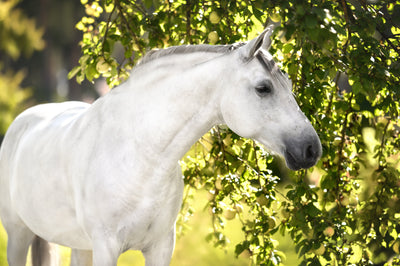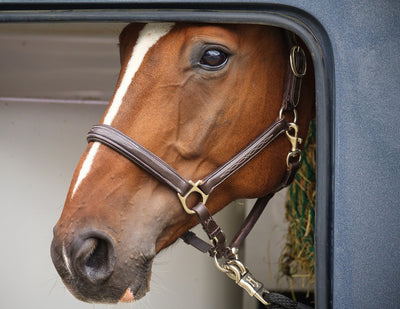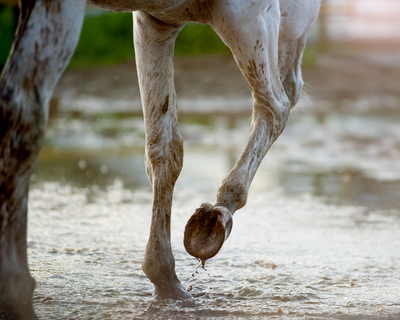Myositis, better known in horses under the term "blood stroke" or "Monday disease", is characterized by inflammation of the muscle tissue.
This inflammation can be more or less severe, and the clinical signs range from simple stiffness to an inability to move.
If we wanted to compare this pathology to what we know in humans, it could be comparable to attacks of violent and generalized muscle cramps.
In horses, this is a phenomenon of destruction of muscle fibers which releases myoglobin into the blood. It will later be eliminated in the urine and its presence will be noted by an abnormally dark color.
This phenomenon can lead to dehydration and overload the kidneys.
The alerts are as follows: the horse seems to have difficulty moving, generally this sensation increases in a very short period of time.
Severe muscle pain changes his locomotion, and he may even have contractions or spasms.
He sweats excessively, and his temperature rises.
He struggles to catch his breath, his breathing rate increases (as well as his heart rate), his urine takes on a dark color.
If you think your horse is showing clinical signs of myositis, you should call a veterinarian immediately. He will carry out a clinical diagnosis which will be confirmed by a blood test, the only way to certify the diagnosis.
What type of horse can be affected by myositis?
Some horses have physical predispositions and can be affected by a form of recurrent myositis. Veterinary support is then essential. Your veterinarian will help you recognize mild seizures and manage them.
Apart from horses with genetic predispositions, they can affect more or less all horses in the following circumstances:
- When returning to work too abruptly after several days of rest. Moreover, it is important during these periods to think about reducing the horse's ration. This allows us to make the link with another cause of myositis: a ration that is too rich for the horse in relation to its physical activity.
- Physical exercise that is too intense or too long, at an inappropriate intensity, can also be the cause of a blood stroke. This is why, in addition to the warm-up (article link warming up your horse) and the recovery time (article recovery link), it is ALWAYS necessary to split the horse's work. Between each exercise, remember to take a break of a few minutes at a walk, allowing the horse to catch his breath and reduce muscular, tendon and even mental pressure.
What to do in case of myositis? If there is any doubt, call a veterinarian immediately.
While waiting for his intervention, you must absolutely avoid moving the horse.
We have the habit of putting the horse in motion when certain pathologies appear.
In the case of myositis, on the contrary, the horse must be kept immobile as long as possible in order to avoid aggravating the symptoms. Remember: we mentioned earlier a breakdown of muscle fibers in cases of myositis, so insisting on keeping the horse moving would contribute to the worsening of this phenomenon.
We must prevent him from eating, and keep him free of access to water.
In case of low temperatures, you must cover the horse well immediately so as not to aggravate muscle contractions which may increase if it is cold.
Massages using relaxing gels or oils (Or relax / or Comfort) can help the affected muscles to reduce inflammation.
After a stroke, hydration is a determining element in the horse's recovery.
Moreover, in certain cases the veterinarian will choose to infuse it in order to help the kidneys to function again, and the body to properly evacuate toxins.
The horse must observe a period of firm rest after the attack.
The downtime following myositis is more or less long, depending on the intensity of the attack, and the horse's ability to eliminate the toxins then present in the muscles, but the duration of rest generally varies from two weeks to one month.
In certain disciplines (such as racing) the horse will be kept in moderate and reduced activity.
A draining treatment (or Draining) combined with a supplement promoting muscle reconstruction and rich in anti-oxidants (Or Muscle) is strongly recommended in order to boost the elimination of toxins, boost the reconstruction of muscle fibers, and therefore help the horse to recover more quickly.
How to avoid bloodshed?
By adapting the horse's ration to its physical activity with the help of your veterinarian if necessary, by reducing the ration during periods of low physical activity, by adapting the work program specifically to your horse, its age, its shape physical, and even outside temperatures, and not your desires or your personal mode of operation.
By taking care of the warm-up (article link) and recovery (article link) phases, by respecting a gradual recovery protocol after downtime or rest periods, by reducing the sources of stress which can be accelerating factors in the nervous horse.
In the event of extreme heat, it is also possible to anticipate by administering electrolytes (Or electrolytes) to the horse undergoing treatment in order to promote the regeneration of salts lost during episodes of increased sweating.








